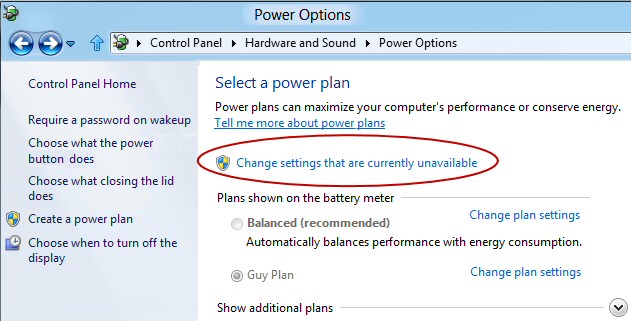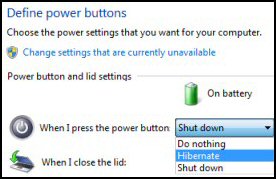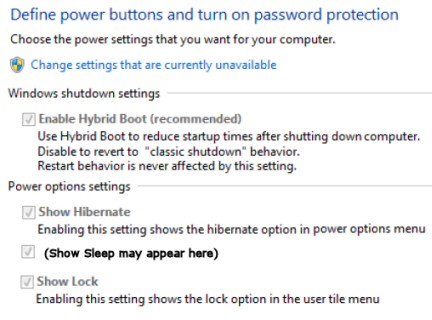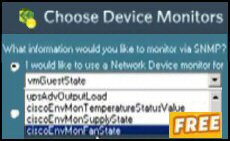Windows 8 Sleep Problems and Hibernate Options
The first thing to realize is there are lots of setting controlling Windows 8’s sleep and hibernation. It follows that people experience a wide range of hibernating related problems.
My point is that you have to work hard to find a description of the exact same sleep predicament that you are troubleshooting, but don’t worry, I have lots of scenarios to help you understand Windows 8’s snoozing habits.
- Changes In Windows 8 Sleep Setting
- The Difference Between Hibernate and Sleep
- Finding the Sleep and Hibernate Settings
- Troubleshooting Windows 8 Sleep Mode and Hibernate
- Premature Waking from Hibernation
♦
Changes In Windows 8 Sleep Menu
In a nutshell, Windows 8’s new hybrid boot technology results in a more responsive awakening from sleep than experienced in previous Microsoft operating systems.
Finding the Power switch in the New UI is a little different from the classic Windows 7 start menu. Typical Microsoft, there are at least 2 ways of causing a machine to slumber!
My favourite method is activating the Metro ‘Charms’ with Winkey +c, then choosing ‘Settings’. You should see the Power switch at the bottom right – see screenshot. Chris points out that WinKey +i would be quicker.
The Difference Between Windows 8 Hibernate and Sleep
A sleeping computer awakens quicker than if you set the same machine set to hibernate. The price to pay is that a sleeping computer could lose unsaved data if someone turns it off, this is because the information is stored in RAM, which is cleared if the operating system powers down.
Although a hibernating machine takes longer to return to its previous state, the data is safe because it reloads the contents of a physical file called hiberfil.sys into memory. Consequently, if your spouse accidentally turned off your machine while it was hibernating your data would still be just as when you left it. Another benefit of hibernation is that it consumes less power than sleep mode.
One more point, Windows 8 also has a setting called ‘Hybrid boot‘, which combines the speed of sleep with the data security of hibernate.
Guy Recommends: SolarWinds Free Wake-On-LAN Utility
Encouraging computers to sleep when they’re not in use is a great idea – until you are away from your desk and need a file on that remote sleeping machine!
WOL also has business uses for example, rousing machines so that they can have update patches applied. My real reason for recommending you download this free tool is because it’s so much fun sending those ‘Magic Packets’. Give WOL a try – it’s free.
Download your free copy of SolarWinds Wake-On-LAN
Finding the Sleep and Hibernate Settings
Microsoft provides 4 methods of finding the Windows 8 Power Settings:
Plan A: Control Panel
Hit the ‘c’ key on the Metro-sytle UI, Select ‘Control Panel’
Hardware and Sound –> Power Options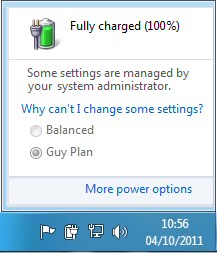
Plan B: Search Settings
Call for the Charms, Winkey +c
Select ‘Search’,
Key Point select ‘Settings’
Type ‘Power ‘
Plan C: Windows 8 PowerCFG
Launch cmd, but firstly seek ‘Run as Administrator’
At the command prompt type
powercfg /?
powercfg -q (Query settings)
powercfg -h on (Hibernation set)
Footnote:
You can disable hibernation with:
powercfg -h off
Exit and restart your computer.
Plan D: (Only if you have battery!)
Switch to the Desktop
Right-click the battery in the Navigation Area,
Left-click the battery and
Select ‘More Power Options’ (See screenshot opposite)
Before you start changing the Power settings consider what you want to achieve, for example, conserving the battery, changing the Power Button options, altering the wake-up triggers, or simply improving security when you are away from the machine.
Windows 8 Power Options
Start your troubleshooting here: Control Panel -> Hardware and Sound -> Power Options.
Tip: Even experienced users forget the significance of ‘Change settings that are currently unavailable’. Keep this link in mind if a setting is greyed out.
Configure The Windows 8 Power Button
Click on ‘Choose what the power button does’ – Key step, see menu above.
This is where you can control what happens when the laptop’s lid closes, or when you press the Power button. If your setting is ‘Greyed out’, then remember my tip and click on: ‘Change settings that are currently unavailable’.
While I only show the ‘On battery’ setting, you can also decide what happens if the laptop is plugged in. Windows 8 has sensors that can detect a mains supply, and when the mains is turned off the operating system connects instantly to the battery, and then applies the appropriate power management settings.
Guy Recommends: A Free Trial of the Network Performance Monitor (NPM) v11.5
v11.5
SolarWinds’ Orion performance monitor will help you discover what’s happening on your network. This utility will also guide you through troubleshooting; the dashboard will indicate whether the root cause is a broken link, faulty equipment or resource overload.
What I like best is the way NPM suggests solutions to network problems. Its also has the ability to monitor the health of individual VMware virtual machines. If you are interested in troubleshooting, and creating network maps, then I recommend that you try NPM now.
Download a free trial of Solarwinds’ Network Performance Monitor
Windows 8 Shutdown Options
As you adjust the Power options settings as shown on the right, visualize the ‘Power’ button below.
If sleep does not appear then check your BIOS settings. If still no ‘Sleep’ option, then my guess is that your display driver does not support this mode. Still stuck? Go back to ‘Choose what the power button does’ link.
Disable Hybrid Boot in Windows 8
Power Options –> ‘Choose what the power button does’ is where you can enable or disable the new Hybrid Boot, this recommended setting halves the time Windows takes to reach the initial logon screen, largely because the Windows core processes retrieve hibernated files, where as drivers rely on a cold boot. However, for troubleshooting you can turn off Enable Hybrid Boot see above screenshot.
Footnote: Hybrid boot is a separate factor from sleep.
Windows 8 Sleep Mode and Hibernate Options
Why Computers Need to Sleep!
For laptop users conserving the battery is a priority. Even for a desktop computer if it’s not use, then there are benefits from managing its power settings; namely, reducing electricity charges, peace and quiet, and in the summer, helping to keep the room cool.
When I work with the graphics at maximum brightness, my Sony Vaio’s battery only lasts for about 2hrs. Therefore, anything that I can do to conserve battery power, will increase the time I can use my laptop away from the mains electricity.
Get Started with: ‘Change settings for the plan’: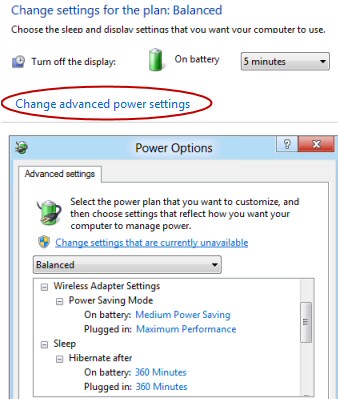
Key Item: ‘Change advanced power settings’
Please remember: Change settings that are currently unavailable.
Windows 8 Sleep and Hibernation
Windows 8’s Hibernation saves information about open programs to a file called hiberfil.sys, which you can inspect in the root of the C: drive. This hidden file keeps your data is safe even if someone switches off the mains, or removes the battery. When the machine restarts, it loads information stored in hiberfil.sys and returns the machine to its former state quickly.
To observe hiberfil.sys, and check its size, you may need to adjust the Windows Explorer’s settings. What I do is go to the Control Panel, Appearance and Personalization, then ‘Show hidden files and folders’. Plan B call for PowerShell and type gci c:\ -hidden.
Once you understand the role of hiberfil.sys, then you appreciate why the Hibernation setting may NOT be present on the menu. For example, if there is insufficient disk space on the C: drive, or ancient BIOS software lacks the ability to ‘Suspend to disk’ or ‘Suspend to RAM’. Another gotcha with the Hibernate option, is that Disk Cleanup deletes the hiberfil.sys file. A solution to this recurring problem is to go to the command line, and type: powercfg -h on.
Incidentally, I discovered that while you cannot move hiberfil to a different volume, you can restrict it's size. Once again it's a task for powercfg, this time you need the -size x% parameter, for example: powercfg -size 20%
Windows 8 Sleep Mode
Windows 8’s Sleep saves your data to RAM and then switches to minimal power mode. There is a 4 second delay as Windows 8 switches back to normal power mode. In the event of a power failure you would lose any unsaved data which is stored in RAM (memory). At this point you will probably have to type in your password to resume after sleep; fortunately, ‘Require a password on wakeup’ is another configurable setting from the task list menu.
Windows 8 Sleep and ARM
Microsoft is partnering with ARM-based manufactures such as NVIDIA, Qualcomm and Texas Instruments to produce new Tablet devices for Windows 8. This ARM support will mean extended battery life as its RISC processor inherently consumes less power.
Guy Recommends SolarWinds’ Free Network Monitor
Thus utility makes it easy to check the health of a router or firewall. Check the real-time performance, and availability statistics, for any device on your network. Get started with an extensive collection of "out-of-the-box" monitors for popular network devices. Give Network Monitor a whirl – it’s free. Download your free Network Device Monitor
If you need more comprehensive network analysis software:
Download a free trial of NPM (Network Performance Monitor)
Troubleshooting Windows 8 Sleep Mode and Hibernate
Sleep and Hibernate settings will never be 100% reliable. I can report that my experience of the same Sony VAIO laptop was as follows: with Windows 8 it’s a pleasure to use Sleep, even Remote Desktop kicks-in straightaway. Whereas with Vista it was a lottery whether it would ever awaken without a hardware reset / reboot. My laptop’s Windows 7 experience was somewhat in-between, tolerable, but lacked the slick seamless coming-to-life of Windows 8.
- Event Viewer
- Does the Bios Support Sleep mode?
- How to Stop Your Computer from Entering Sleep Mode
- Windows 8 Hibernate Problem
- Windows 8 Sleep Problem – Taskbar Disappears
- Where is the Standby Menu Option?
- Windows 8 Stops Responding – Will not Wake from Hibernation
Event Viewer (Windows System Log)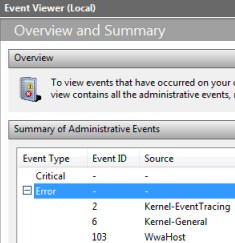
When Windows 8 has a problem, I am trying to train myself to begin troubleshooting by inspecting the Windows logs. At the new Metro UI type ‘ev’ and then look in ‘Settings’.
A good place to start in the Event Viewer is with ‘Summary of Administrative Events’. Follow-up by looking in the System Log and filtering for ‘Kernel-Power’ entries. Interesting items would include ‘The last sleep transition was unsuccessful’, or ‘The system is entering sleep’.
Power Options
I am willing to bet that 70% of all Hibernate and Sleep problems are due to inappropriate settings in the Power Options (Control Panel, Hardware and Sound). For example, if you don’s see a Hibernate option on the Shutdown menu, then check whether ‘Allow hybrid sleep’ is set to ‘on’. You could investigate by pressing the Windows key +x on a laptop, or Start Search, powercfg.cpl on a desktop computer. See screen shot of Allow hybrid sleep
Does the Bios Support Sleep Mode?
If the computer has a ‘Certified for Windows 7’ then there is a good chance that all the power management features will work. It’s just up to you to configure Sleep or Hybrid Sleep, or else complain to the supplier / manufacturer.
To check your computer’s BIOS interrupt the initial boot phase, the special key is usually F2 or the delete key, else try the spacebar. If all else fails read the boot screen! Once you have intercepted the BIOS boot, just examine carefully any options which could enable / disable Sleep. The settings are usually,
S3 – Suspend to RAM (Sleep)
or
S4 Suspend to Disk (Hibernate)
Idea: See if there any updates for your BIOS. If so a later version may cure your sleep problems.
How to Stop Your Computer from Entering Sleep Mode
1) Navigate to the ‘Power Options’ (Start Search powercfg.cpl)
or see above.
2) Select your power plan.
3) Click: Change plan settings.
4) Crucial Links: a) Change advanced powers settings.
b) Change settings that are currently unavailable.
5) Research the myriad of settings, in particular: ‘Sleep’
6) Expand: ‘Sleep after’. If it’s a laptop check both the ‘Plugged in’ and the ‘On Battery’ settings.
7) Choose: ‘Never’ to prevent your computer going into sleep mode.
8) Remember to click ‘OK’. (Or apply if you want to configure more options.)
Monitor Your Network with the Real-time Traffic Analyzer
The main reason to monitor your network is to check that your all your servers are available. If there is a network problem you want an interface to show the scope of the problem at a glance.
Even when all servers and routers are available, sooner or later you will be curious to know who, or what, is hogging your precious network’s bandwidth. A GUI showing the top 10 users makes interesting reading.
Another reason to monitor network traffic is to learn more about your server’s response times and the use of resources. To take the pain out of capturing frames and analysing the raw data, Guy recommends that you download a copy of the SolarWindsfree Real-time NetFlow Analyzer.
Premature Waking from Hibernation
All manner of software and hardware can trigger Windows 8 to wakeup from Sleep or Hibernate. Thus the first question is the old chestnut: ‘Is this insomniac behaviour due to Hardware or Software?’
Hardware
USB devices are common causes for computers waking prematurely. In the case of accidental mouse activation, consider laying the mouse on its back until you find a better solution.
To troubleshoot the Sleep Mode problem visit the Device Manager
1) Control Panel –> System and Security –> System –> Device Manager.
2) Right-click the suspect device
3) Properties
4) See if it has a Power Management Tab.
5) If so, then remove the tick next to: ‘Allow this device to wake up the computer’.
Hardware Example: The Network adapter –> Advanced menu
Select: ‘Wake up capability’. Choose ‘None’.
Software
Plan A) Blame the Task Scheduler! Start Search, Task Scheduler. (Else look in Administrative Tools)
i) You are bound to find suspects.
ii) 95% of them will be innocent programs that need to be scheduled.
iii) Good luck in weeding out the true culprit(s).
Plan B) Blame a virus checker.
Plan C) Blame a virus!
Try a completely different strategy, investigate what is happening by using Performance monitor, however, this is a black art.
See more about performance monitoring »
Reverse Problem – Computer Won't Awaken from Sleep
I have an idea to cure computers that sleep, but won't wake up when you press a key.
- Launch the Device Manager
- Scroll down to Keyboard
- Select the Power Management (Tab)
- Tick Allow this device to wake the computer.
Where Is the Windows 8 Standby Menu Option?
Forget Standby. Windows 8 replaces XP’s Standby with Sleep.
Do remember that you can ‘Switch User’ this will save the other person’s open files. Not really a sleep or hibernate setting, just an idea for a specific circumstance.
Summary of Windows 8 Sleep Mode and Hibernate
Ever since XP it has been a worry to users whether a computer will actually awaken from Hibernate or Sleep. However, with each succeeding Windows version, sleep seems more reliable, and the Windows 8 computers seem to magically to wake-up when you tickle them with the mouse our Enter key.
It has always been the case that power management is more important on a laptop than a desktop, consequently they have more components to configure, for example the battery, and also the lid.
If you like this page then please share it with your friends
Microsoft Windows 8 Troubleshooting Topics
• Windows 8 Overview • Win 8 Event Viewer • Windows 8 Shutdown • Windows 8 Join Domain
• Windows 8 Performance Monitor • Windows 8 PowerCfg -Energy • Windows 8 Sleep Problems
• Windows 8 Troubleshooting • Windows 8 Sound Problems • Win 8 Server Admin Tools • Tookit



